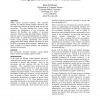Free Online Productivity Tools
i2Speak
i2Symbol
i2OCR
iTex2Img
iWeb2Print
iWeb2Shot
i2Type
iPdf2Split
iPdf2Merge
i2Bopomofo
i2Arabic
i2Style
i2Image
i2PDF
iLatex2Rtf
Sci2ools
CHI
1999
ACM
1999
ACM
Inferring Intent in Eye-Based Interfaces: Tracing Eye Movements with Process Models
While current eye-based interfaces offer enormous potential for efficient human-computer interaction, they also manifest the difficulty of inferring intent from user eye movements. This paper describes how fixation tracing facilitates the interpretation of eye movements and improves the flexibility and usability of eye-based interfaces. Fixation tracing uses hidden Markov models to map user actions to the sequential predictions of a cognitive process model. In a study of eye typing, results show that fixation tracing generates significantly more accurate interpretations than simpler methods and allows for more flexibility in designing usable interfaces. Implications for future research in eye-based interfaces and multimodal interfaces are discussed. Keywords Eye movements, eye-based interfaces, tracing, hidden Markov models, user models, cognitive models.
CHI 1999 | Eye Movements | Eye-based Interfaces | Hidden Markov Models | Human Computer Interaction |
| Added | 02 Aug 2010 |
| Updated | 02 Aug 2010 |
| Type | Conference |
| Year | 1999 |
| Where | CHI |
| Authors | Dario D. Salvucci |
Comments (0)

